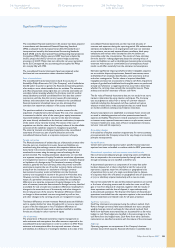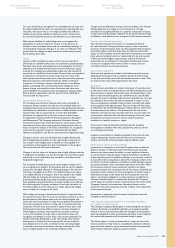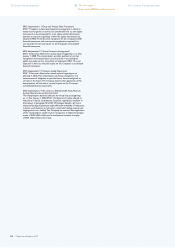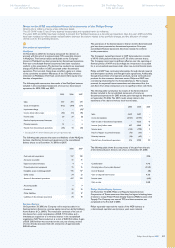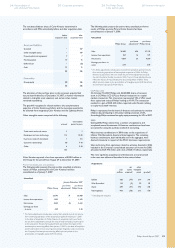Philips 2007 Annual Report Download - page 199
Download and view the complete annual report
Please find page 199 of the 2007 Philips annual report below. You can navigate through the pages in the report by either clicking on the pages listed below, or by using the keyword search tool below to find specific information within the annual report.
Philips Annual Report 2007 205
Signicant IFRS accounting policies
The consolidated nancial statements in this section have been prepared
in accordance with International Financial Reporting Standards
(IFRS) as adopted by the European Union (EU). All standards and
interpretations issued by the International Accounting Standards
Board (IASB) and the International Financial Reporting Interpretations
Committee (IFRIC) effective year-end 2007 have been adopted by
the EU, except that the EU carved out certain hedge accounting
provisions of IAS 39. Philips does not utilize this carve-out permitted
by the EU. Consequently, the accounting policies applied by Philips
also comply fully with IFRS.
The consolidated nancial statements have been prepared under
the historical cost convention, unless otherwise indicated.
Basis of consolidation
The consolidated nancial statements include the accounts of
Koninklijke Philips Electronics N.V. (‘the Company’) and all subsidiaries
that fall under its power to govern the nancial and operating policies
of an entity so as to obtain benets from its activities. The existence
and effect of potential voting rights that are currently exercisable are
considered when assessing whether the Company controls another
entity. Subsidiaries are fully consolidated from the date that control
commences until the date that control ceases. All intercompany
balances and transactions have been eliminated in the consolidated
nancial statements. Unrealized losses are also eliminated but
considered an impairment indicator of the assets transferred.
The purchase method of accounting is used to account for the
acquisition of subsidiaries by the Company. The cost of an acquisition
is measured as the fair value of the assets given, equity instruments
issued and liabilities incurred or assumed at the date of exchange,
plus costs directly attributable to the business combination, irrespective
of the extent of any minority interest. The excess of the cost of
acquisition over the fair value of the Company’s share of the identiable
net assets of the subsidiary acquired is recognized as goodwill.
The minority interests are disclosed separately in the consolidated
statements of income as part of prot allocation and in the
consolidated balance sheets as a separate component of equity.
Foreign currencies
The nancial statements of entities that use a functional currency other
than the euro, are translated into euros. Assets and liabilities are
translated using the exchange rates on the respective balance sheet
dates. Items in the income statement and cash ow statement are
translated into euros using the average rates of exchange for the
periods involved. The resulting translation adjustments are recorded
as a separate component of equity. Cumulative translation adjustments
are recognized as income or expense upon partial or complete disposal
or liquidation of a foreign entity. The functional currency of foreign
entities is generally the local currency, unless the primary economic
environment requires the use of another currency. Gains and losses
arising from the translation or settlement of foreign currency-
denominated monetary assets and liabilities into the functional
currency are recognized in income in the period in which they arise.
However, currency differences on intercompany loans that have the
nature of a permanent investment are accounted for as translation
differences as a separate component of equity. Changes in the fair
value of monetary securities denominated in foreign currency classied
as available for sale are split into translation differences resulting from
changes in the amortized cost of the security and other changes in
the carrying amount of the security. Translation differences related
to changes in the amortized cost are recognized in prot or loss,
and other changes in the carrying amount are recognized in equity.
Translation differences on non-monetary nancial assets and liabilities
such as equities held at fair value through prot or loss are reported
as part of the fair value gain or loss. Translation differences on
non-monetary nancial assets such as equities classied as available-
for-sale are included in other reserves in equity.
Use of estimates
The preparation of nancial statements requires management to
make estimates and assumptions that affect amounts reported in the
consolidated nancial statements in order to conform to IFRS. These
estimates and assumptions affect the reported amounts of assets
and liabilities, the disclosure of contingent liabilities at the date of the
consolidated nancial statements, and the reported amounts of
revenues and expenses during the reporting period. We evaluate these
estimates and judgments on an ongoing basis and base our estimates
on experience, current and expected future conditions, third-party
evaluations and various other assumptions that we believe are
reasonable under the circumstances. The results of these estimates
form the basis for making judgements about the carrying values of
assets and liabilities as well as identifying and assessing the accounting
treatment with respect to commitments and contingencies. Actual
results could differ materially from the estimates and assumptions.
Estimates signicantly impact goodwill and other intangibles acquired,
tax on activities disposed, impairments, nancial instruments, assets
and liabilities from employee benet plans, other provisions and tax
and other contingencies. The fair values of acquired identiable
intangibles are based on an assessment of future cash ows. Impairment
analyses of goodwill and indenite-lived intangible assets are performed
annually and whenever a triggering event has occurred to determine
whether the carrying value exceeds the recoverable amount. These
analyses are based on estimates of future cash ows.
The fair value of nancial instruments that are not traded in an active
market is determined by using valuation techniques. The Company
uses its judgment to select from a variety of common valuation
methods including the discounted cash ow method and option
valuation models and to make assumptions that are mainly based
on market conditions existing at each balance sheet date.
Actuarial assumptions are established to anticipate future events and
are used in calculating pension and other postretirement benet
expense and liability. These factors include assumptions with respect
to interest rates, expected investment returns on plan assets, rates of
increase in health care costs, rates of future compensation increases,
turnover rates, and life expectancy.
Accounting changes
In the absence of explicit transition requirements for new accounting
pronouncements, the Company accounts for any change in accounting
principle retrospectively.
Reclassications
Certain items previously reported under specic nancial statement
captions have been reclassied to conform with the 2007 presentation.
Discontinued operations and non-current assets held for sale
Non-current assets (disposal groups comprising assets and liabilities)
that are expected to be recovered primarily through sale rather than
through continuing use are classied as held for sale.
A discontinued operation is a component of an entity that either
has been disposed of, or that is classied as held for sale, and (a)
represents a separate major line of business or geographical area
of operations; (b) is a part of a single coordinated plan to dispose
of a separate major line of business or geographical area of operations;
or (c) is a subsidiary acquired exclusively with a view to resale.
Non-current assets held for sale and discontinued operations are carried
at the lower of carrying amount and fair value less costs to sell. Any
gain or loss from disposal of a business, together with the results of
these operations until the date of disposal, is reported separately
as discontinued operations. The nancial information of discontinued
operations is excluded from the respective captions in the consolidated
nancial statements and related notes for all years presented.
Cash ow statements
Cash ow statements are prepared using the indirect method. Cash
ows in foreign currencies have been translated into euros using the
weighted average rates of exchange for the periods involved. Cash
ows from derivative instruments that are accounted for as fair value
hedges or cash ow hedges are classied in the same category as the
cash ows from the hedged items. Cash ows from other derivative
instruments are classied consistent with the nature of the instrument.
Segments
Operating segments are components of the Company’s business
activities about which separate nancial information is available that is
Group nancial statements
- Signicant IFRS accounting policies
Company nancial statements 250 Corporate governance246 Reconciliation of
non-US GAAP information 258 The Philips Group
in the last ten years 260
Investor information












